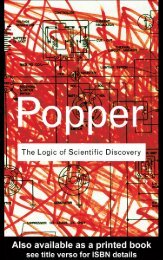Create successful ePaper yourself
Turn your PDF publications into a flip-book with our unique Google optimized e-Paper software.
HOW PEIRCEAN WAS THE “‘FREGEAN’ REVOLUTION” IN LOGIC? 14<br />
his Johns Hopkins University students with diagrammatic representations of the four combinations that two terms can<br />
take with respect to truth values. A circular array for the values �� ���, a��, ��b, and ab, each combination occupying its<br />
own quadrant:<br />
��b ab<br />
�� ��� a��<br />
appeared in the lecture notes from the autumn of 1880 of Peirce’s student Allan Marquand (1853–1924) (see editors’<br />
notes, [Peirce 1989, 569]). An alternative array presented by Peirce himself (see editors’ notes, [Peirce 1989, 569]),<br />
and dating from the same time takes the form of a pyramid:<br />
a��<br />
a��<br />
ab �� ���<br />
Finally, and also contemporaneous with this work, and continuing to experiment with notations, Peirce developed<br />
his “box-X” or “X-frame” notation, which resemble the square of opposition in exploring the relation between<br />
the relations between two terms or propositions. Lines may define the perimeter of the square as well as the diagonals<br />
between the vertices; the presence of connecting lines between the corners of a square or box indicates the states in<br />
which those relations are false, or invalid, absence of such a connecting line indicates relations in which true or valid<br />
relation holds. In particular, as part of this work, Peirce developed a special iconic notation for the sixteen binary connectives,<br />
as follows (from “The Simplest Mathematics” written in January 1902 (“Chapter III. The Simplest Mathematics<br />
(Logic III)”, MS 431; see [Clark 1997, 309]) containing a table presenting the 16 possible sets of truth values<br />
for a two-term proposition:<br />
1 2 3 4 5 6 7 8 9 10 11 12 13 14 15 16<br />
F F F F T T T T F F F F T T T T<br />
F F F T F T F F T T F T F T T T<br />
F F T F F F T F T F T T T F T T<br />
F T F F F F F T F T T T T T F T<br />
that enabled him to give a quasi‐mechanical procedure for identifying thousands of tautologies from the substitution<br />
sets of expressions with up to three term (or proposition) variables and five connective variables. This table was clearly<br />
inspired by, if not actually based upon, the table presented by Christine Ladd-Franklin (née Ladd; (1847–1930) in<br />
her paper “On the Algebra of Logic” for the combinations �� ���, a��, ��b, and ab [Ladd-Franklin 1883, 62] who, as she<br />
noted [Ladd-Franklin 1883, 63], borrowed it, with slight modification, from Jevons’s textbook, The Principles of Science<br />
[Jevons 1874; 1879, 135]. She pointed out [Ladd-Franklin 1883, 61] that for n terms, there are 2 n -many possible<br />
combinations of truth values, and she went on to provide a full-scale table for the “sixteen possible combinations of<br />
the universe with respect to two terms. Writing 0 and 1 for false and true respectively and replacing the assignment of<br />
the truth-value false with the negation of the respective terms, she arrived at her table [Ladd-Franklin 1883, 62]<br />
providing sixteen truth values of {��}, {a��}, {��b}, and {ab}.<br />
In his X-frames notation, the open and closed quadrants are indicate truth or falsity respectively, so that for example,<br />
�, the completely closed frame, represents row 1 of the table for the sixteen binary connectives, in which all<br />
assignments are false, and x, the completely open frame, represents row 16, in which all values are true (for details, see





